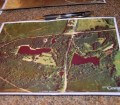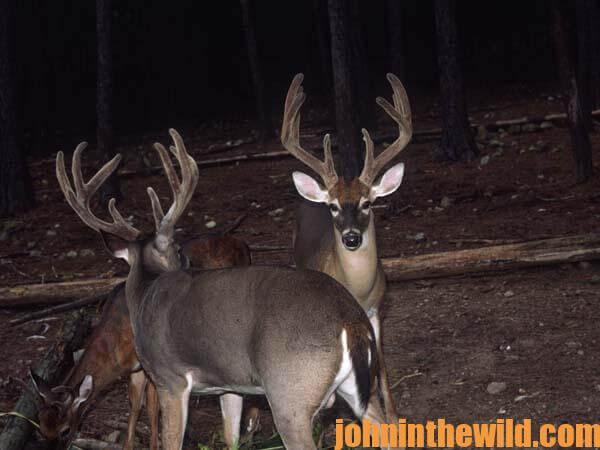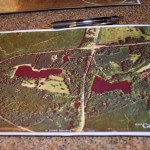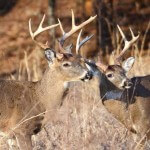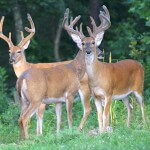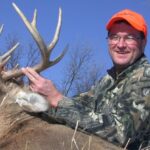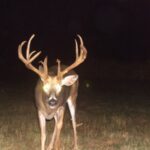John’s Note: This week we’re learning secret tactics used by trophy deer hunters before they set foot in the woods – to locate the terrain and cover that holds the basket-racked bucks. You can find the buck you want this season or at least learn where he should be while studying on your kitchen table this summer. Many hunters spend too much time walking around in the woods and not enough time learning how to hunt their areas and identifying where bucks move. An aerial photo and a topographic map can show you where deer are most likely to appear, how to increase your hunting time and how to decrease your scouting time.
The best times to study your maps are before and during hunting season.
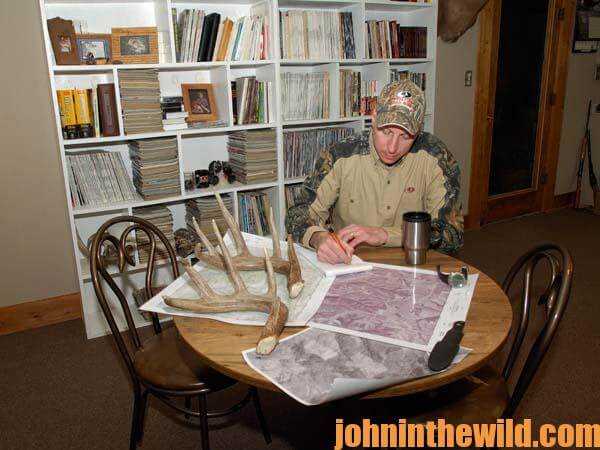 The most-productive way to scout is to walk in the woods with your maps as soon as hunting season closes. “When you go into the woods after hunting season, you usually can see where other hunters have been hunting, spot the trails deer have been using and learn the land quicker when the leaves are off the trees than if you go into the woods before hunting season begins,” Bo Pitman, longtime deer guide and avid hunter, reports. “By entering the woods after hunting season, you often will find the places where the big bucks have been hiding all year long and know where to find them in the absence of hunting pressure.”
The most-productive way to scout is to walk in the woods with your maps as soon as hunting season closes. “When you go into the woods after hunting season, you usually can see where other hunters have been hunting, spot the trails deer have been using and learn the land quicker when the leaves are off the trees than if you go into the woods before hunting season begins,” Bo Pitman, longtime deer guide and avid hunter, reports. “By entering the woods after hunting season, you often will find the places where the big bucks have been hiding all year long and know where to find them in the absence of hunting pressure.”
The second-best time to scout woods utilizing your maps and aerial photos is during the summer or 2 – 3 weeks before hunting season arrives. Search for deer trails. See if deer are using the funnels you’ve found. Study the changes in the land, and search for bucks. No matter how much you learn from an aerial photo and a topo map, you still have to ground-check the assumptions you’ve made from your maps to be successful taking deer.
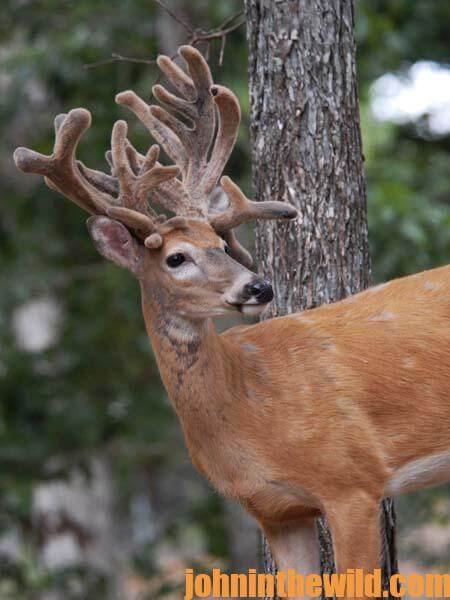 “Another factor to consider is the types of woodlots you have to hunt,” Pitman advises. “In many areas of the North, deer may concentrate in numbers of small woodlots. If you have small woodlots to hunt, then you’re limited as to where you can put up your stands. But if you have large woodlots to hunt, you can change your stands often.”
“Another factor to consider is the types of woodlots you have to hunt,” Pitman advises. “In many areas of the North, deer may concentrate in numbers of small woodlots. If you have small woodlots to hunt, then you’re limited as to where you can put up your stands. But if you have large woodlots to hunt, you can change your stands often.”
Many northern hunters have great success hunting tiny (20 – 50 acres) sites. Two very productive trophy deer hunters I know – Ernie Calandrelli of New York and Mike Monteleone of Maryland – hunt small acreages. Calandrelli owns 30 acres next to public lands in his home state that he hunts only a couple of days each season and takes trophy bucks. Monteleone looks for places with long driveways, assuming there may be small plots of land available for bowhunting in this horse country. Monteleone may hunt only 6-8 acre tracts between fields for the horses but find nice bucks there.
Pitman is convinced that a stand that has been hunted from three times is not as effective as it is the first time it’s used. “When I ground-check an area I’ve located on my map and see my assumptions are right and that the deer are where I’ve thought, I mark that stand site on my map,” Pitman reports. “I assume that after I’ve hunted out of that stand three or four times that deer in that area probably will change their movement patterns. Then I return to my map, look for another way to come into that general area from a different direction and pick another stand site. Usually I will have four or five different ways to get to various stands in the same part of the woods where I’ve found deer to be traveling.
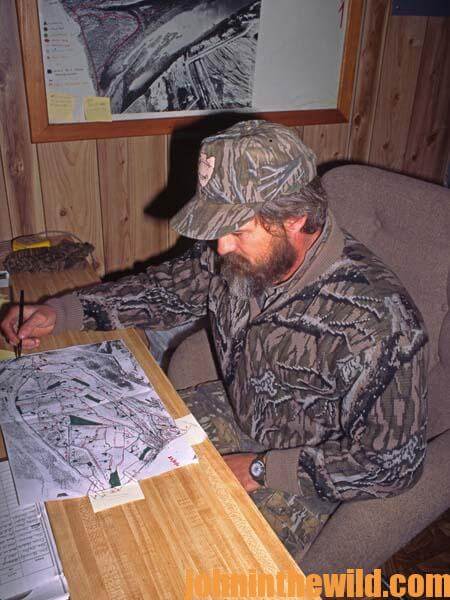 “To be consistently successful in bagging a buck on any given piece of property, you must surprise the deer. You have to be in a place where he’s not expecting you to be at a time he’s not expecting you to be there. Therefore, when you locate a region after or before the season where deer are traveling, don’t be content to choose one stand site. You may not be able to hunt from that stand on any given day because of wind direction. Instead of having the wind in your face, the wind may be coming from your back and blowing your scent into that area. Anytime you find a productive-looking spot to hunt on your map or while scouting, always look for several alternative stand sites and different directions from which to come into that same region. Then when you listen to the weather report in the morning, and the weatherman tells you which way the wind is blowing, you’ll know which route to choose and which stand site to utilize to hunt deer in that section of the woods. Mark multiple stand sites on your map as well as designate which way the wind must be blowing for you to effectively hunt each of these stand sites. By having this information on your map or GPS each morning before you leave for the woods, you’ll be able to choose the very-best stands on your map to hunt from that day. Keep a pocket reference with the stands numbered and the designated wind direction you need to hunt from each stand. Then if the wind changes during the day, you will know which stands to move to and to hunt from with a favorable wind.”
“To be consistently successful in bagging a buck on any given piece of property, you must surprise the deer. You have to be in a place where he’s not expecting you to be at a time he’s not expecting you to be there. Therefore, when you locate a region after or before the season where deer are traveling, don’t be content to choose one stand site. You may not be able to hunt from that stand on any given day because of wind direction. Instead of having the wind in your face, the wind may be coming from your back and blowing your scent into that area. Anytime you find a productive-looking spot to hunt on your map or while scouting, always look for several alternative stand sites and different directions from which to come into that same region. Then when you listen to the weather report in the morning, and the weatherman tells you which way the wind is blowing, you’ll know which route to choose and which stand site to utilize to hunt deer in that section of the woods. Mark multiple stand sites on your map as well as designate which way the wind must be blowing for you to effectively hunt each of these stand sites. By having this information on your map or GPS each morning before you leave for the woods, you’ll be able to choose the very-best stands on your map to hunt from that day. Keep a pocket reference with the stands numbered and the designated wind direction you need to hunt from each stand. Then if the wind changes during the day, you will know which stands to move to and to hunt from with a favorable wind.”
Several of my friends enjoy using the ScoutLook Weather DeerLog app, a weather and deer management/planning tool for deer hunters.
To get John E. Phillips’ Kindle eBooks and print books on hunting deer, “How to Hunt and Take Big Buck Deer on Small Properties,” (John’s latest book), “How to Hunt Deer Up Close: With Bows, Rifles, Muzzleloaders and Crossbows,” “PhD Whitetails: How to Hunt and Take the Smartest Deer on Any Property,” “How to Take Monster Bucks,” and “How to Hunt Deer Like a Pro,” or to prepare venison, “Deer & Fixings,” click here.

